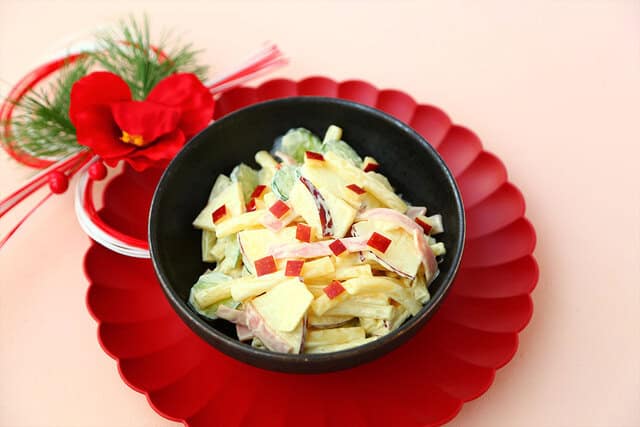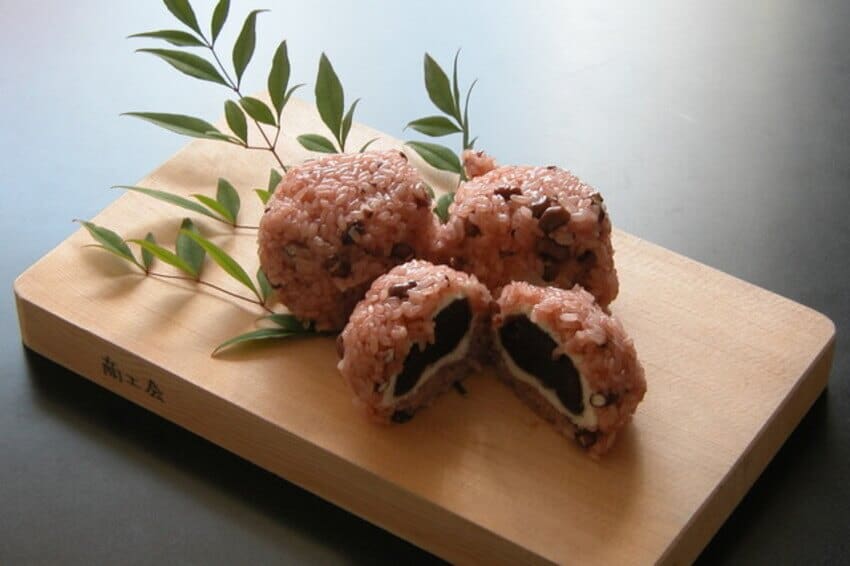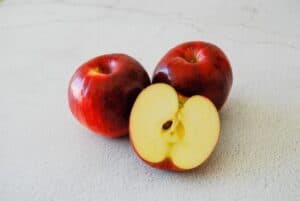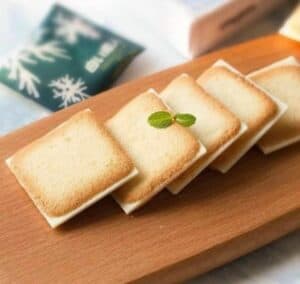Apples are one of the fruits that Japanese people widely love. Aomori Prefecture is known as “Japan’s best apple prefecture.” Many believe it is the best in Japan for its quality and variety. But have you ever explored its charm in depth? In this article, we will explore the world of Aomori apples and their secrets and charms.
What is Aomori Apple?

Aomori Apple (青森りんご) refers to apples that are grown in the Aomori Prefecture of Japan. Aomori is a region known for its high-quality apples, and the climate and soil conditions in the area contribute to the production of flavorful and crisp apples. The Aomori Prefecture, located in the northern part of Honshu, Japan’s main island, has a climate that includes cold winters and warm summers, creating favorable conditions for apple cultivation. The apples produced in Aomori are often sought after for their sweetness, juiciness, and overall high quality.
Various apple varieties are grown in Aomori, including the Aomori Apple brand, which encompasses different types such as Fuji, Tsugaru, and Hachinohe. The climate and soil conditions of the Aomori Prefecture contribute to the quality of the apples grown there. The cold winters and warm summers play a role in developing the sweetness and crispness of the fruit.
Aomori Apple History

Apples have their roots in mountainous areas like the Caucasus Mountains in Central Asia and the Tianshan Mountains in China. Over time, they spread to different parts of the world. The history of Aomori apples traces back to the early Meiji period.
In 1871, Western apple varieties were brought to Japan, and three small apple trees were given to Aomori Prefecture in 1875 by the Ministry of Home Affairs Kangyoryo and the prefectural office. Over the following years, hundreds of apple plants were distributed to farmers for trial planting. In the 7th year of Meiji, Reverend John Ing, an American missionary, introduced Western apples to Aomori by distributing them to students and believers during the Nativity Festival on December 25th.
This event marked the initial introduction of Western apples to the prefecture. Principal Kuro Kikuchi played a significant role by planting the seeds in his garden and later grafting the scion onto different rootstocks. This led to the breeding and widespread cultivation of apples in the prefecture.
About Aomori prefecture harvest

The Aomori Prefecture located in the northern part of Honshu, Japan’s main island. In Aomori Prefecture, one of the world’s leading production complexes formed in the Tsugaru region, it is currently Japan’s number-one apple kingdom, accounting for approximately 60% of the nation’s apple production. The apple industry in Aomori Prefecture plays a vital role economically in culture and tourism. Aomori Prefecture continues to improve its production system by increasing production capacity by rejuvenating orchards and promoting labor-saving, low-cost production, and environment-friendly apple cultivation through methods such as dwarf cultivation and bagless cultivation.
Variety of Aomori apple production ratio

Looking at the 2021 production, Aomori apples account for approximately 63% of the national output. Fuji accounts for 50% of production by variety, followed by Tsugaru and Orin at 10% each, followed by Jonagold. Of the top four producing varieties, the three types other than the early maturing “Tsugaru” have an excellent shelf life and support year-round sales. This is the strength of the apples locals produced in Aomori Prefecture.
Types of Aomori apple
Main red apples grown in Aomori Prefecture
Miki Life

Locals harvested these apples earlier than Tsugaru, a typical early variety, and have a well-balanced flavor. The name “Miki Life” comes from the main character of the 1986 taiga drama “Miki Takahara.” It weighs about 250g and is red in color with stripes. The pulp is slightly firm and has a lot of juice, with a good balance of sweet and sour.
Tsugaru

The production volume in Aomori Prefecture is second only to Fuji. The bright red “Tsugaru” harvest begins as the short northern summer ends. At approximately 300g, the fruit skin has bright red stripes and red color. The pulp is hard and dense. It is rich in fruit juice, has an intense sweetness, and has almost no sourness.
Fuji

Farmers carefully bag each “Fuji” one by one. Although it is time-consuming, the fruit skin becomes smooth and bright red. Locals stored the harvested “Fuji” in a special refrigerator to maintain its freshness and goes into a deep sleep until spring. It becomes the mainstay of apple sales from spring to summer when other varieties are scarce. The fruit skin has brownish-red stripes. The pulp is slightly coarse and has a crunchy texture. It has a lot of fruit juice and has an excellent balance of sweetness and acidity.
Main yellow apples grown in Aomori Prefecture
Toki

Weighing around 350g, the fruit has yellow skin, and some have a slight vermilion tinge. It is rich in fruit juice, has an intense sweetness, and has a pleasing aroma inherited from Orin.
Shinano Gold

Characterized by its sour taste, which is unusual among yellow apples. This variety has excellent storage stability, so you can enjoy its crispy texture until spring. It is fragrant and juicy, with high sugar content and plenty of acidity.
Star gold coin

The name “Star Gold Coin” is a registered trademark of Aomori Prefecture. It’s a reasonable size, weighing around 250g to 300g, and the peel is yellow. It has a high sugar content of about 15-16% and has excellent storage stability.
Aomori Apple FAQ
- What is the harvest season of Aomori Apple?
Apple harvest season in Aomori, Japan, is from July to November. Some varieties become available as early as August. The mid-season apples are harvested in October, and the Fuji variety is ready for harvest in November. Those gathered by around September 20th are popularly famous as “early maturing varieties,” those harvested by around October 20th is the “mid-maturing varieties,” and those harvested after October 20th are the “late maturing varieties.”
- Why is apple cultivation so widespread in Aomori Prefecture?
One of the reasons why Aomori Prefecture became an apple-producing prefecture is the climate. Aomori Prefecture’s summer climate is cool and perfect for growing apples. In addition, for apples to change color and produce firm fruits with high sugar content, low temperatures in early autumn and a difference in temperature between day and night are necessary, which applies to Aomori Prefecture’s climate.
Some Apple Dishes
Apple Candy

Apple candy has a good texture and is recommended for refreshing the palate of dishes or as a rest for chopsticks.
Kohaku Namasu

The red apple and white radish represent the red and white mizuhiki and praying for peace in the family which they consider a lucky charm.
Apple Salad

Apple salad is an indispensable part of home cooking in Aomori, as it is easy to adjust the gaps between the pieces. Perfect when tired of the standard New Year’s dishes.
Aomori Apple Recipe

Aomori Apple Ingredients
| Ingredients of Kohaku Namasu for 4 persons | Measurements |
|---|---|
| Apple | 60g |
| Japanese white radish | 7g |
| Apple cider vinegar | 42g |
| Sugar | 28g |
| Salt | 7g |
How to make Aomori Apple?
Cut the apples into strips with the skin on (you can also use a slicer to cut them into strips). Then, peel the radish and cut it into strips in the same way as the apples.
Sprinkle salt on the apples and daikon radish, set aside, and squeeze out any excess water.
Mix apple cider vinegar and sugar in a bowl, add them, let it mix, and serve on a plate.
Where to buy Aomori Apple?
Taisho Roman Cafe (大正浪漫喫茶室)

Taisho Roman Cafe, a popular, stylish cafe in Aomori, is located in the Fujita Memorial Garden in front of Hirosaki Park. Here, you can eat apple pies from 6 stores in the city. They serve apple pie from “No Life”. A smooth apple pie filled with chunky apples. They used a lot of cinnamon here. Highly recommended for cinnamon lovers.
Strauss (シュトラウス)

This is a famous patisserie in Aomori, where you can enjoy authentic Austrian sweets. Our pastry chefs are full-fledged Austrian confectioners. They have Australia’s classic sweet “Upfelstrudel” (served with fresh cream). It’s like the Australian version of apple pie. They wrapped the Aomori apples and raisins in thinly rolled pie dough and baked.
Nico Cakes (ニコ ケークス)

Niko Cakes is a patisserie that is known for its cute exterior. Popular items include roll cakes, cream puffs, and rare cheesecakes. Apples from Aomori Prefecture are soaked in syrup and baked while being covered with batter.
Final Thoughts

In conclusion, Aomori Apples’ origins dating back to the early Meiji period, have become synonymous with quality and flavor. The Aomori Prefecture’s unique climate and soil conditions contribute to these apples’ exceptional taste and crispness, making them sought after both within Japan and internationally.
You can check some Japanese confectionery dishes that we know you would like to try too.
















Comments